Alternate Findings
A Simpler Base-2 System
There are other alternative ways to define the letters in two, three, four, six and even more than eight cases that are homogeneously distributed, similar to the previous approach. Let’s evaluate just the Base-2:
Letter
A
B
Binary
X0
X1
Ups-Downs
↓
↑↓
Occurrences
1/2
1/2
Period
2
2
This Base-2 representation makes it easier to analyze smaller sequences composed of just A's and B's. For example, Image 8 shows the first 32 sequences and provides insight into the vertical order.
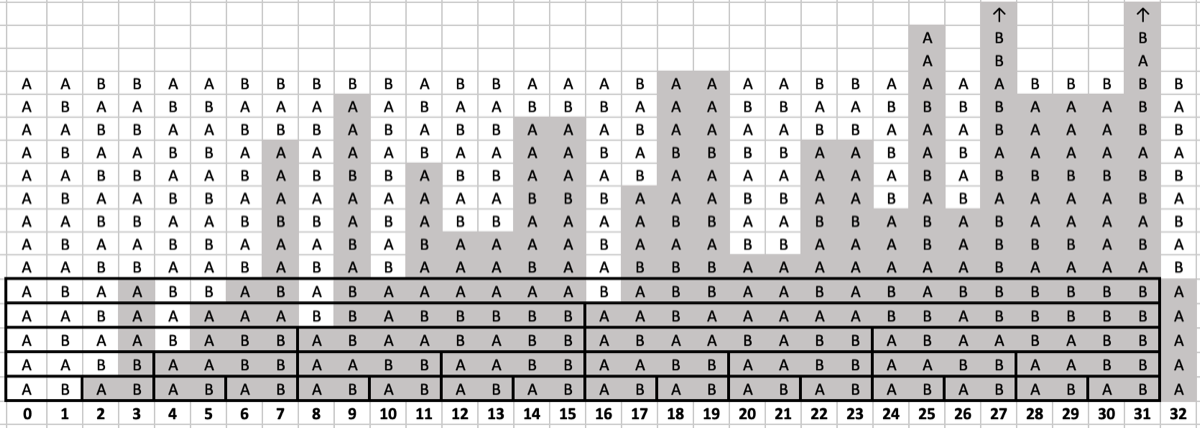
Image 28. Base-2 sequences representation.
Again, zero is defined as any amount of consecutive As. But now the letter B is different from the previous Base-32 order, and therefore, when the number 1 is reached, then there is any amount of consecutive B and A, because that represents the ending loop 1→4→2.
We try to gain a clue into how each horizontal repetition is defined. For instance, the least significant digit follows the expected pattern: A and B. However, subsequent digits might become irregular. The second digit is still regular: A, A, B, B, it's inferred that the third sequence should be A, A, A, A, B, B, B, B. But it has a B at the second position, and therefore, a replacement A should be located at the second position of the second half, like this: A, B, A, A, B, A, B, B.
On the fourth it happens the same but on the third position. But the next one is more irregular, the only pattern is that the entire horizontal repetition can be deduced from looking at the first half of it, because the second half is the same but inverted. And the same horizontal order applies. The first N digits of any sequence repeats after (2^N) repetitions.
This is why the 27-sequence started to appear much earlier than 32^30. When you do the same in this other numeric system, the 27-sequence is 70 digits long and 2^70 (1180591620717411303424) is exactly the difference to the number when it starts to repeat. The same number calculated before.
Precision Limitation
A Collatz sequence is never repeated. Regardless of whether expressed in numerical form or
simplified letter notation (using Base-2 or Base-32), each sequence is unique.
Upon analyzing the various facets of this intricate base-32 fractal, we observe that any group of adjacent sequences exhibits a base height defined by the height of the sequence 2^N below it. For any integer N, sequences of numbers higher than 2^N have lengths greater than N.
Consider those cases where the sequence goes up and then down in many steps. Why is there not a single sequence that keeps going up indefinitely with this pattern?
Defining a peak as a two-step sequence which goes up and then down (letter B, in Base-2). When having a sequence with consecutive peaks, the calculation of each high value n in the sequence is as follows, where x is the starting number in the peaks sequence:
High (x, n) = ((2x + 2) * (1.5^n)) - 2
Noticeably, (1.5^n) results in a non-integer value. Moreover, the more consecutive peaks (higher values of n), the lower the integer precision of this result.
n
1
2
3
4
5
6
7
8
(1.5^n)
1.50000000
2.25000000
3.37500000
5.06250000
7.59375000
11.39062500
17.08593750
25.62890625
(2x + 2) binary
xxxxxxx0
xxxxxx00
xxxxx000
xxxx0000
xxx00000
xx000000
x0000000
00000000
(x+1) binary
xxxxxxxx
xxxxxxx0
xxxxxx00
xxxxx000
xxxx0000
xxx00000
xx000000
x0000000
x binary
xxxxxxxx
xxxxxxx1
xxxxxx11
xxxxx111
xxxx1111
xxx11111
xx111111
x1111111
Therefore, (2x + 2) multiplied by (1.5^n) needs to be an integer and this is covered by all (x + 1) that have a minimum of (n - 1) trailing zeros or x that have a minimum of (n -1) trailing ones. There are many cases, but the important part is that there is a limitation in the number of consecutive peaks that an initial number x can generate. This limitation is imposed by the order of magnitude of x. Let's view this with a few examples and a practical conclusion.
The first peak is at x = 1. Which generates the following sequence: 1, 4, 2, 1. Being binary x = 1.
The second consecutive peak (2 peaks) is at x = 3 with: 10, 5, 16, 8, 4, 2, 1. Being binary x = 11.
The third consecutive peak is at x = 7. Being binary x = 111.
The fourth consecutive peak is at 15. Being binary x = 1111.
And the pattern continues, every next consecutive peak is at x = (2^n)-1.
In general, for any x number lower than (2^n), the maximum amount of leading consecutive peaks is n peaks, reached by a single number. This number is (2^n)-1. For example, if n = 13 the maximum number of leading peaks generated from a number lower than (2^13) is 8191 which generates 13 leading peaks.
It is clear that, it is not possible to have an infinite sequence of peaks generated by any finite number x because the magnitude of x will impose a "precision limitation".
Another way to see the precision limitation is as follows: In Base-2 order, consider the peak as the letter B. The only way to get a consecutive B after a sequence of trailing Bs is by multiplying by 2 and adding 1 which is the equivalent of concatenating a 1 at the end of any binary number. So, yes you can increase the number of initial consecutive peaks but finitely, the moment the final trailing B step gets calculated it will find a letter A and the value will start decreasing.
The same limitation applies to the increasing letters F, G and H in base-8 order, but multiplying by their respective periods 32, 32 and 16. That is, if you have some trailing Gs for example, and you want to have another one, you need to multiply the original number by 32. And the same applies to any combination of F, G and H.
There is no finite number that generates an ever-increasing Collatz sequence composed of a combination of letters F, G and H.
However, this precision limitation only applies when calculated from the initial value. In sequence 31 for instance, the initial sequence is just 5 peaks, but further in the same sequence there is a 6-peak pattern, because the sequence keeps on bouncing in values that are higher than 2^5, reaching number 319 which generates 6 consecutive peaks because 319 in binary is 100111111 with six trailing ones and reaching 4616 at the highest value and then dropping to 1.
Binary Correlation to Peaks and Downs
When analyzing the binary representation of numbers in a Collatz sequence (numeric representation, no letters), several intriguing patterns emerge:
According to the Collatz rules, the last bit of a number determines whether the first calculation in the sequence increases or decreases. If the last bit is 1 (odd number), the sequence goes up; if it is 0 (even number), the sequence goes down. This behavior repeats at every step, dictated by the last bit of the number at that stage.
But what can the preceding bits of the original number tell us about the sequence's behavior? Interestingly, if a number ends with N trailing zeroes, it undergoes precisely N divisions by 2 (steps "down"). This happens because dividing a number by 2 in binary simply removes the last zero, leaving the rest of the representation unchanged.
Similarly, numbers ending in N trailing ones exhibit a predictable behavior. Each trailing one generates a "peak," which involves two steps: an upward step followed by a downward step. This occurs because multiplying an odd number by 3 and adding 1 in binary produces an even result, with the last bit becoming 0 while preserving the trailing sequence of ones. The subsequent division by 2 then removes the zero.
This correlation between peaks or downs and the binary ending of a number is limited by the first bit that changes before the trailing sequence of ones or zeroes. Beyond this point, the binary structure no longer directly determines the sequence's behavior.
A compelling visualization of this phenomenon involves representing binary sequences as patterns of black and white squares instead of 1s and 0s. For example, Image 9 and 10 show the initial 17 binary steps for the Collatz sequences of 63 and 127.
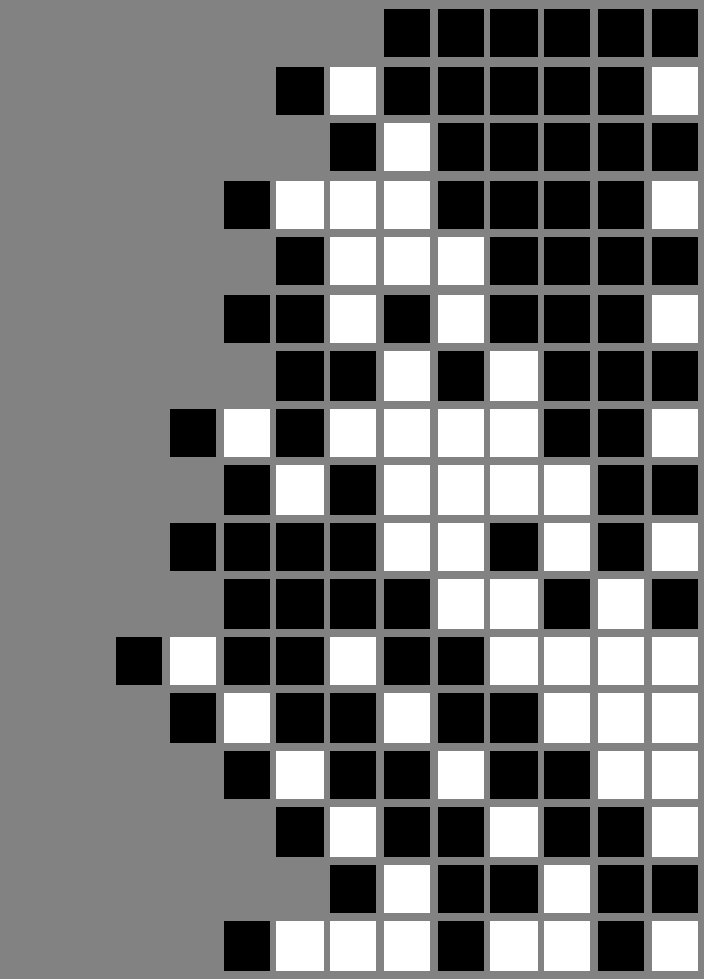
Image 29. Number 63
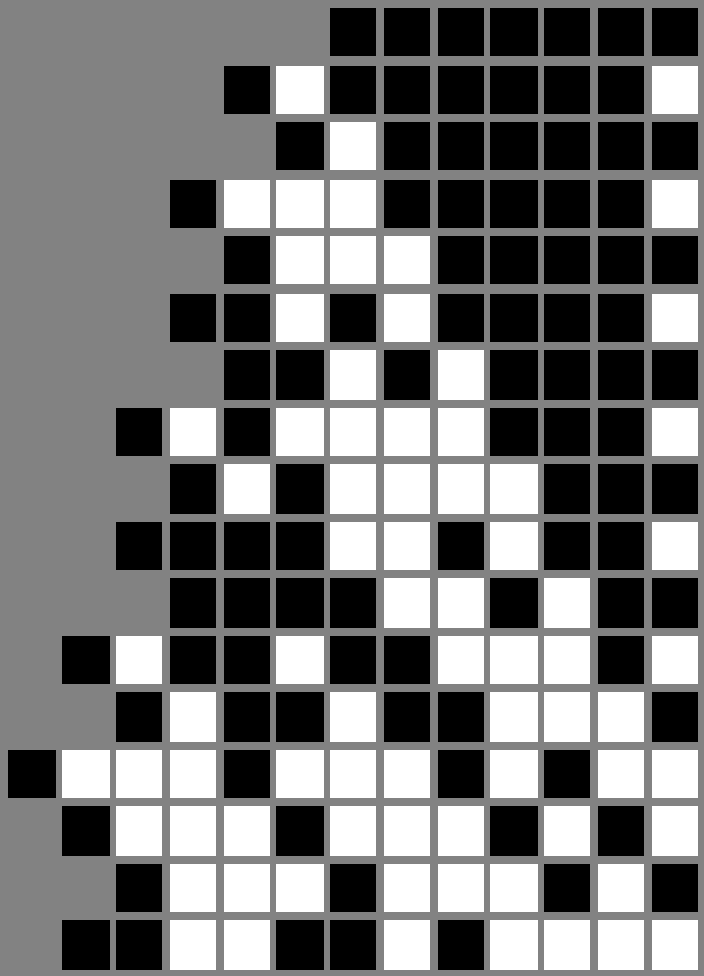
Image 30. Number 127
Both 63 and 127 begin with six and seven trailing ones, respectively, represented as consecutive black squares. Correspondingly, they each generate six and seven consecutive peaks. As the sequences progress, the number of trailing ones decreases peak by peak. Notably, the remaining bits to the left of these trailing ones show striking similarities between the two sequences. Further analysis could uncover the underlying rules governing these commonalities.
The same applies to numbers ending in trailing zeroes. Images 11 and 12 illustrate all the binary steps for the Collatz sequences of 160 and 320.
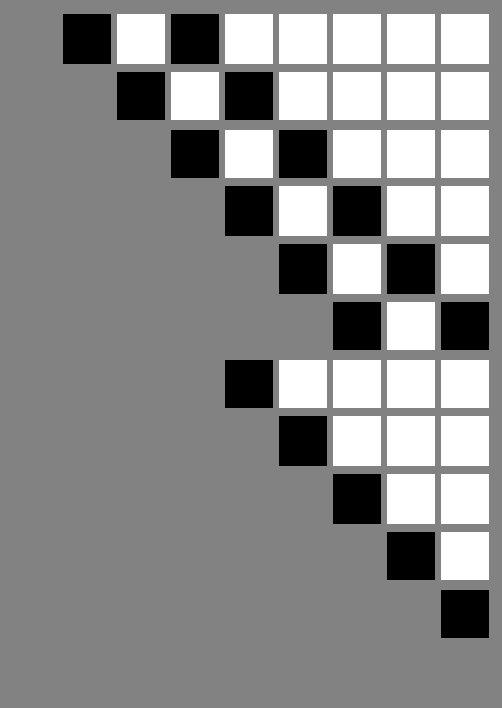
Image 31. Number 160
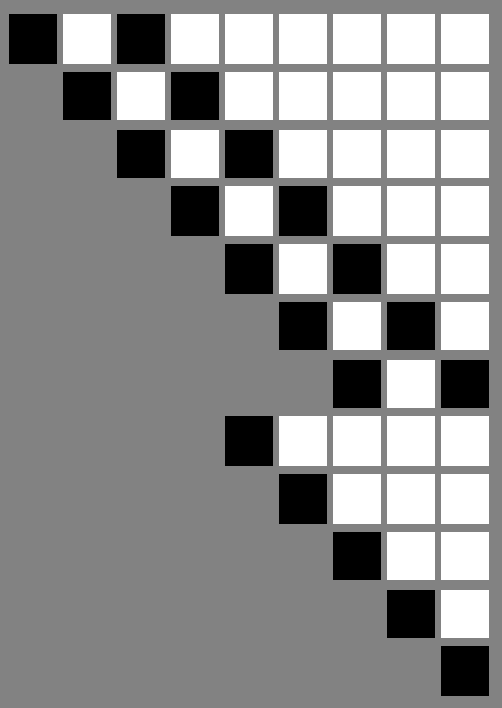
Image 32. Number 320
Both 160 and 320 have five and six trailing zeroes, respectively, represented as consecutive white squares. These trailing zeroes correspond to five and six consecutive divisions by 2. As the sequences progress, the last bit is removed while the remaining bits stay unchanged, resulting in a bitwise right shift.
Bitwise Right Shift
The bitwise visualization was adjusted to ensure that the steps shown are x/2 for even numbers and (3x+1)/2 for odd numbers. This adjustment is based on the fact that 3x+1 always results in an even number. As a result, the right shift occurs in a single step for both ending bits (0 or 1).
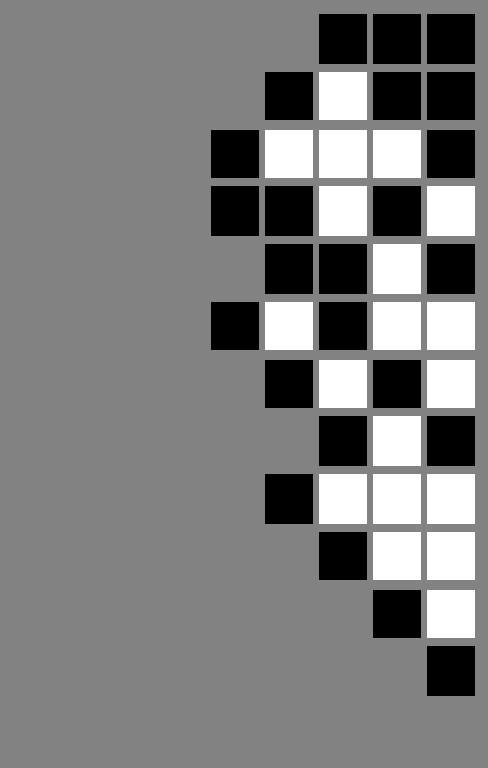
Image 33. Number 7
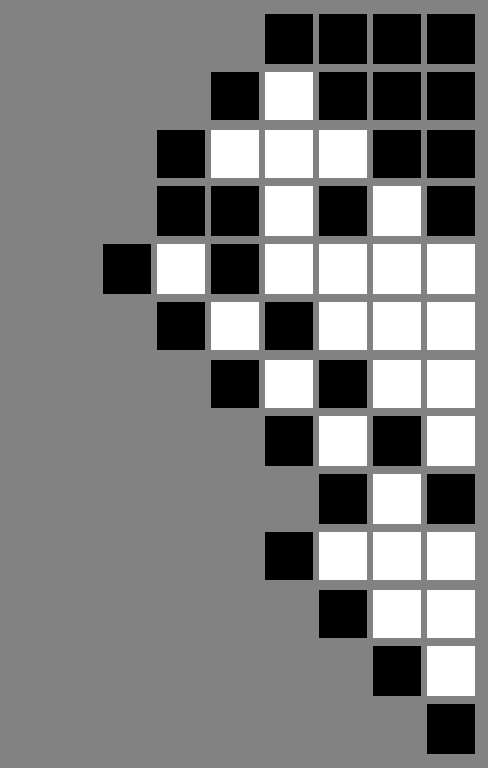
Image 34. Number 15
Dividing by two, applied only to even numbers or those ending in 0 in binary, is as simple as removing the last zero. The resulting binary representation is one bit shorter, while the remaining bits stay unchanged:
XYZ0 / 2 = XYZ
This operation directly performs a right shift, leaving the other bits unaltered.
Multiplying by 3 and adding 1 in binary involves multiplying by 2 and adding the original number, followed by adding 1:
(XYZ1 x3) + 1 = XYZ10 + XYZ1 + 1 = XYZ11 + XYZ1
This result always ends in 0, making it divisible by 2:
(XYZ11 + XYZ1) / 2 = XYZ1 + XYZ + 1
This is equivalent to the original value plus half of it, rounded up. Since the last bit of the original number is 1, the next value in the sequence is:
XYZ1 + XYZ + 1 = XYZ0 + XYZ + 10
This ensures that the last bit of the next number matches the previous one Z, enforcing the right shift effect for trailing ones.
In fact, one of the terms in the sum is already the shifted value XYZ (not exclusively with 3 digits). So the difference to the original right shift is imposed by the term XYZ0 + 10. And the more trailing zeroes it has, the less difference it imposes.
So, the rest of the bits depend on the values in XYZ0 + 10 and the result is never a pure right shift. While trailing ones exhibit the right-shift effect on the portion with ones, the rest result in a more mixed outcome.
During the creation of the bitwise graphic, it was observed that the proportion of bits that do not represent a right shift of the previous number is remarkably low, fluctuating between 0% and 18%.
This indicates a strong tendency for right shifts, with at least 82% of transitions in the modified Collatz sequence ((3x+1)/2) exhibiting this behavior. However, trailing ones (peaks) can occasionally cause a size increase of up to one extra bit, which counters the overall shrinking tendency.
In the most extreme cases, sequences develop alternating pockets of trailing ones that lead to higher numbers with trailing zeroes. These trailing zeroes shrink the size of subsequent values—sometimes significantly, sometimes not enough—before trailing ones reappear. Despite these fluctuations, all the sequences checked always converge to 1.
This process can be compared to an attempt to cross the ocean by jumping from rock to rock. Some rocks provide an extra boost, enabling you to reach distant rocks that were otherwise out of reach. However, most rocks either lead you into the water, washing you closer to the shore, or to another rock nearer to shore.
Within any 2^n range, there is a finite quantity of numbers with trailing ones. The likelihood of encountering the next number with trailing ones is proportional to the order of magnitude and inversely proportional to the number of trailing ones already encountered.

Image 35. Number 27
© baKno LLC. All rights reserved. Contact